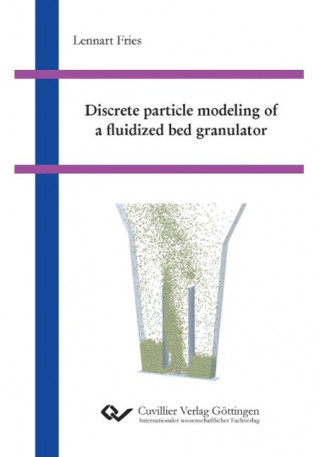
Code: 13415702
Discrete particle modeling of a fluidized bed granulator
by Lennart Fries
Size-enlargement and structuration processes in fluidized beds such as granulation and agglomeration play an important role in the pharmaceutical and fine chemical industries as well as in food technology to improve the flowabilit ... more
- Language:
 English
English - Binding: Paperback
- Number of pages: 222
Publisher: Cuvillier Verlag, 2012
- More about this

270.37 zł
RRP: 284.64 zł
You save 14.26 zł

In stock at our supplier
Shipping in 5 - 7 days
You might also like
Give this book as a present today
- Order book and choose Gift Order.
- We will send you book gift voucher at once. You can give it out to anyone.
- Book will be send to donee, nothing more to care about.
More about Discrete particle modeling of a fluidized bed granulator
You get 157 loyalty points
 Book synopsis
Book synopsis
Size-enlargement and structuration processes in fluidized beds such as granulation and agglomeration play an important role in the pharmaceutical and fine chemical industries as well as in food technology to improve the flowability and the instant properties of solid products. Dustfree and free-flowing particles can be produced in a process with favourable heat- and mass transfer conditions. Furthermore, this technology allows the formulation of particles with novel functionalities by applying coating layers or via the encapsulation of active ingredients. Several interdependent micro mechanisms including particle collisions, wetting, drying and phase transitions govern the process dynamics and complicate predictions on the effect of variable operating conditions on product properties such as structure, strength and re-dissolution behaviour. Profound knowledge on these mechanisms is needed to understand the influence of individual process parameters on the final product properties.A suitable approach to model the particle interactions in fluidized beds is the Discrete Element Method (DEM) coupled with Computational Fluid Dynamics (CFD). Information on gas and particle velocities, particle rotation and collision dynamics, which are very complicated to measure in fluidized beds, can be studied in detail with this technique.This thesis presents DEM-CFD simulation results for three different granulator configurations (top-spray, Wurster-coater, spouted bed) in comparison to experimental results, regarding the agglomeration of amorphous maltodextrin (DE 21). In simulation and experiment the identical geometry of the equipment was used. Mechanical material properties, such as the coefficient of restitution and the Young's modulus, which are required for the DEM model and which are frequently used as fitting parameters, were measured via static and dynamic deformation tests using maltodextrin agglomerates, beads and bars. The strength of the experimentally produced agglomerates was characterized with a compression tester. Their flow behaviour was assessed with the help of a shear cell.Very promising results were obtained showing that the homogeneity of particle wetting can well be approximated with the residence time distribution of the particles inside the spray zone.Homogeneous wetting allows achieving a narrow product size distribution (Fries et al., 2011a).Furthermore, the growth rate of the agglomerates can well be correlated with the simulated wetting intensity, the collision frequency and the collision velocity distribution inside the spray zone. The agglomerate strength shows a strong correlation with the particle-wall collision frequency and velocity distribution found in the simulations. Good agreement was found between the simulation results for the maximum particle deformation and for the energy dissipation during collisions and the measured deformation at the breakage point and the breakage energy.Due to the high numerical effort, DEM is only suitable for small scale applications. However, the obtained information on the kinetics of particle-particle interactions can be applied as input for macroscopic process models in the framework of a multi scale modeling scheme (Fries et al., 2011b; Werther et al., 2011).It can be concluded that DEM is a powerful tool for the detailed characterization of fluidized bed granulators. Highly relevant practical answers can be obtained from the model such as the choice of the optimal equipment geometry depending on material properties and product requirements. The model can point out where to position the spray nozzles in order to achieve homogeneous particle wetting and if a draft tube is helpful to maintain stable particle circulation. Based on such findings the model shows potential to increase the throughput of a fluidized bed granulator, while avoiding a bed collapse.
 Book details
Book details
270.37 zł
- Full title: Discrete particle modeling of a fluidized bed granulator
- Author: Lennart Fries
- Language:
 English
English - Binding: Paperback
- Number of pages: 222
- EAN: 9783954042456
- ISBN: 3954042452
- ID: 13415702
- Publisher: Cuvillier Verlag
- Weight: 416 g
- Dimensions: 250 × 176 × 12 mm
- Date of publishing: 29. October 2012
Trending among others
-

Dune
34.84 zł -33 % -

Haunting Adeline
125.81 zł -1 % -

Berserk Deluxe Volume 2
212.65 zł -1 % -

White Nights
15.40 zł -23 % -

Powerless
47.24 zł -14 % -

Atomic Habits
59.22 zł -26 % -

Dune Messiah
46.33 zł -3 % -

Berserk Deluxe Volume 3
215.07 zł -1 % -

One Day
32.63 zł -36 % -

Berserk Deluxe Volume 1
211.84 zł -2 % -

Iron Flame
62.95 zł -26 % -

Surrounded by Idiots
37.77 zł -26 % -

Harry Potter and the Prisoner of Azkaban (Minalima Edition)
170.44 zł -2 % -

Gravity Falls Journal 3
89.65 zł -

Heaven Official's Blessing: Tian Guan Ci Fu (Novel) Vol. 1
89.04 zł -1 % -

The Creative Act
100.22 zł -15 % -

Dune
47.34 zł -23 % -

Hunting Adeline
86.73 zł -34 % -

A Little Life
47.24 zł -14 % -

Children of Dune
46.73 zł -2 % -

Heaven Official's Blessing: Tian Guan Ci Fu (Novel) Vol. 2
86.73 zł -3 % -

Bungo Stray Dogs, Vol. 8 (light novel)
65.07 zł -7 % -

Percy Jackson and the Olympians 5 Book Paperback Boxed Set
185.55 zł -5 % -

Solo Leveling, Vol. 1
86.73 zł -3 % -

The Prisoner's Throne
34.84 zł -31 % -

Court of Thorns and Roses
43.41 zł -15 % -

Cry Baby Coloring Book
47.34 zł -1 % -

Fourth Wing
56.60 zł -26 % -

Icebreaker
35.15 zł -26 % -

Berserk Deluxe Volume 6
215.07 zł -1 % -

Avatar, the Last Airbender: The Kyoshi Novels (Box Set)
169.23 zł -2 % -

The 48 Laws of Power
101.63 zł -12 % -

House of Leaves
85.82 zł -33 % -

Twisted Lies
37.77 zł -26 % -

Dune Messiah
38.07 zł -33 % -

No Longer Human
65.07 zł -6 % -

48 Laws Of Power
61.14 zł -28 % -

Twisted Games
37.77 zł -26 % -

Caraval Paperback Boxed Set
175.58 zł -3 % -

Solo Leveling, Vol. 2
75.04 zł -23 % -

Open Circuits
169.63 zł -2 % -

Berserk Deluxe Volume 5
152.61 zł -29 % -

Heaven Official's Blessing: Tian Guan Ci Fu (Novel) Vol. 3
84.81 zł -6 % -

Berserk Deluxe Volume 4
221.81 zł -23 % -

Court of Mist and Fury
36.56 zł -26 % -

SOLO LEVELING V08
88.44 zł -2 % -

English File Upper Intermediate Multipack A (4th)
100.63 zł -

CHAINSAW MAN V14
42.90 zł -23 % -

Before the Coffee Gets Cold
33.94 zł -26 %
safisfied customers
Since 2008, we have served long line of book lovers, but each of them was always on the first place.
Copyright! ©2008-24 libristo.pl All rights reservedPrivacyPoučení o cookies



 21 million books
21 million books Delivery 12.99 zł
Delivery 12.99 zł (32) 444 93 66 (8-15.30h)
(32) 444 93 66 (8-15.30h)